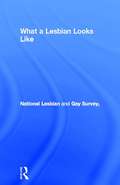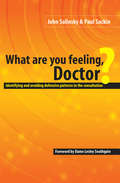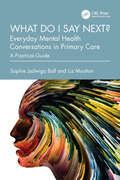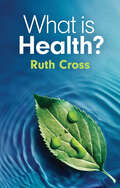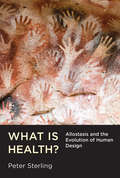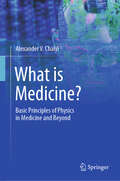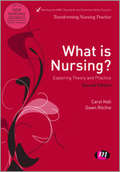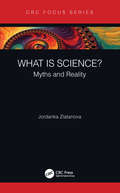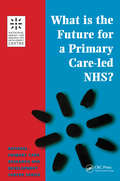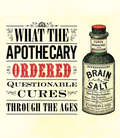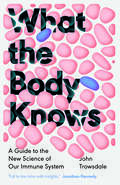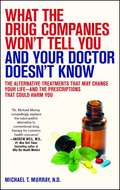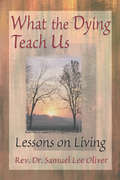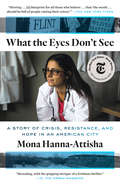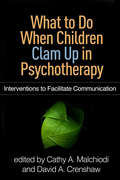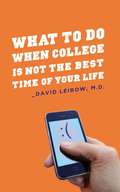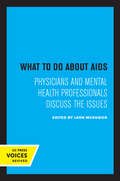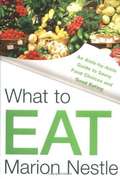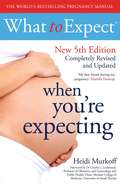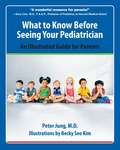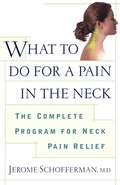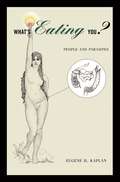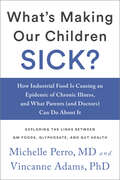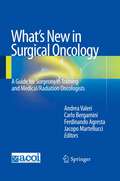- Table View
- List View
What a Lesbian Looks Like
by National Lesbian and Gay SurveyThe National Lesbian and Gay Survey is a mass observation project set up in 1985 to record the experience of lesbians and gay men. Since that time, lesbian and gay volunteers have provided accounts on a wide range of issues pertinent to lesbian and gay life. "What a Lesbian Looks Like" draws on this material to provide an anthology of personal writings from lesbians nationwide. The volunteers come from all walks of life, from the unemployed to holders of high powered jobs, and represent all age groups. A ll aspects of lesbian experience are covered, including first sexual encounters, long term relationships, the difficulties of "coming out" and Clause 28. This book should be of interest to undergraduates, postgraduates and academics in the fields of women's studies, gender studies and cultural studies.
What are You Feeling Doctor?: Identifying and Avoiding Defensive Patterns in the Consultation
by John Salinsky Paul SackinGuidelines are powerful instruments of assistance to clinicians capable of extending the clinical roles of nurses and pharmacists. Purchasers and managers perceive them as technological tools guaranteeing treatment quality. Guidelines also offer mechanisms by which doctors and other health care professionals can be made more accountable to their patients. But how can clinicians tell whether a guideline has authority and whether or not it should be followed? Does the law protect doctors who comply with guidelines? Are guideline developers liable for faulty advice? This timely book provides a comprehensive and accessible analysis of the many medical and legal issues arising from the current explosion of clinical guidelines. Featuring clear summaries of relevant UK US and Commonwealth case law it is vital reading for all doctors health care workers managers purchasers patients and lawyers.
What do I say next? Everyday Mental Health Conversations in Primary Care: A Practical Guide
by Liz Moulton Sophie Jadwiga BallA significant problem experienced by some GPs and many trainees and other primary care health professionals is the challenge of completing a useful and safe consultation with patients with mental health problems within the constraints of a standard-length appointment. These challenges may arise from a lack of specific expertise in this area, poor training in the relevant skills and, perhaps, the attitude that there is not much that the primary care practitioner can do to help.This new book focuses on enhancing the repertoire of communication skills available for mental health consultation, providing a range of tools and techniques drawn from accepted models, including cognitive behavioural therapy (CBT), transactional analysis (TA), motivational interviewing and acceptance commitment therapy (ACT), illustrating how to apply these within a typical 10- to 12-minute primary care consultation.Key features: enhances the repertoire of communication and consultation skills for primary care practitioners working in mental health consultations summaries and quick take-home points aid rapid reference in the time-constrained consultation setting whether in person or virtual offers worked-through model consultations with a variety of patients, showing how to apply the tools and techniques described demonstrates how such consultations can be completed safely and effectively within a normal consultation time frame Essential reading for all primary care practitioners in training and in practice, the book equips readers with the confidence and knowledge to provide excellent mental health care for their patients.
What is Health?
by Ruth CrossWhat is health? What does health mean to people? How do we make sense of health and experience it? There are no simple answers to these questions. Health is complex, subjective and varied. Drawing on theory, research and contemporary debates, Ruth Cross explores the nature of health in depth and challenges our thinking about it. Moving beyond taken-for-granted assumptions, she gives the meaning of ‘health’ its due attention, exploring everyday perspectives as well as ‘expert’ medical, academic and policy understandings and approaches. In doing so, the book brings together different knowledge and expertise on health, also considering the inextricable links between human and planetary health. This book is important for all those working in the health field, or training to do so, seeking a broad understanding about health and all its complexity.
What is Health?: Allostasis and the Evolution of Human Design
by Peter SterlingAn argument that health is optimal responsiveness and is often best treated at the system level. Medical education centers on the venerable “no-fault” concept of homeostasis, whereby local mechanisms impose constancy by correcting errors, and the brain serves mainly for emergencies. Yet, it turns out that most parameters are not constant; moreover, despite the importance of local mechanisms, the brain is definitely in charge. In this book, the eminent neuroscientist Peter Sterling describes a broader concept: allostasis (coined by Sterling and Joseph Eyer in the 1980s), whereby the brain anticipates needs and efficiently mobilizes supplies to prevent errors. Allostasis evolved early, Sterling explains, to optimize energy efficiency, relying heavily on brain circuits that deliver a brief reward for each positive surprise. Modern life so reduces the opportunities for surprise that we are driven to seek it in consumption: bigger burgers, more opioids, and innumerable activities that involve higher carbon emissions. The consequences include addiction, obesity, type 2 diabetes, and climate change. Sterling concludes that solutions must go beyond the merely technical to restore possibilities for daily small rewards and revivify the capacities for egalitarianism that were hard-wired into our nature. Sterling explains that allostasis offers what is not found in any medical textbook: principled definitions of health and disease: health as the capacity for adaptive variation and disease as shrinkage of that capacity. Sterling argues that since health is optimal responsiveness, many significant conditions are best treated at the system level.
What is Medicine?: Basic Principles of Physics in Medicine and Beyond
by Alexander V. ChalyiThis book looks into the world of medicine through a unique lens - the principles of physics. Beginning with a brief history of medical physics and Feynman's classification of natural phenomena, it delves into topics such as the electrical activity of cells, and the physical basis of synaptic transmission, using nonlinear models that reveal their behavior as a strange attractor. Using a synergetic analogy between similar processes occurring in physical and neurophysiological systems, the author is able to formulate the first principle describing the emergence of hexagonal grid cells structures in the brain. It also explores the use of thermal imaging in the diagnosis, the dosimetry of ionizing radiation, and the physical basis of effective methods of quantum mechanics in modern medicine. Through detailed discussion of topics including synergetics, physiology, neurology, and radiation medicine, the reader gains a deep understanding of the physics behind medical diagnostics and treatments. Each chapter is devoted to exploring one of the directions of theoretical or clinical medicine, featuring parts written on different popular and rigorous physical levels. Providing a comprehensive overview of the physical principles of medicine and how they relate to medical equipment and technology, this book is a bridge between the fields of medicine and physics, demonstrating how the two can work together to advance the science of healthcare. This book is a valuable resource for anyone interested in the intersection of medicine and physics and the possibilities for future innovation.
What is Nursing? Exploring Theory and Practice
by Carol Hall Dawn RitchieThis book helps new nursing students, and those thinking of entering the profession, understand what it is to be a nurse in today's rapidly changing healthcare environments. The new edition includes a new first chapter on becoming a nursing student, with insights from students themselves. The book also explains the process of nursing and systems of care delivery which underpin actual practice. A chapter on international working is included for those working or studying abroad. Finally, it explores what nursing is really like when you qualify through interviews with registered nurses in each of the main nursing fields of practice.
What is Nursing?: Exploring Theory and Practice (Transforming Nursing Practice)
by Carol Hall Dawn RitchieThis book helps new nursing students, and those thinking of entering the profession, understand what it is to be a nurse in today's rapidly changing healthcare environments. The new edition includes a new first chapter on becoming a nursing student, with insights from students themselves. The book also explains the process of nursing and systems of care delivery which underpin actual practice. A chapter on international working is included for those working or studying abroad. Finally, it explores what nursing is really like when you qualify through interviews with registered nurses in each of the main nursing fields of practice.
What is Science?: Myths and Reality
by Jordanka ZlatanovaIn a multitude of ways, science affects the life of almost every person on earth. From medicine and nutrition to communication and transportation, the products of scientific research have changed human life. These changes have mostly taken place in the last two centuries, so rapidly that the average person is unable to keep informed. A consequence of this "information gap" has been the increasing suspicion of science and scientists. The lack of true understanding of science, especially of "fundamental" research, motivates this effort to narrow this gap by explaining scientific endeavor and the data-driven worldviews of scientists. Key Features Fills an existing void in the understanding of science among the general population Is written in a nontechnical language to facilitate understanding Covers a wide range of science-related subjects: The value of "basic research" How scientists work by sharing results and ideas How science is funded by governments and private entities Addresses the possible dangers of research and how society deals with such risks Expresses the viewpoint of an author with extensive experience working in laboratories all over the world
What is the Future for a Primary Care-Led NHS?
by Robert BoydTax planning can lead to considerable efficiencies, but few GPs have been trained as businessmen. This book in "The Business Side of General Practice" series, provides a guide to the regulations, identifies the pitfalls and opportunities and shows how to maximize the income retained by the practice. John Dean is known for his writing on financial management in general practice and has also written "Making Sense of Practice Finance" (Radcliff).
What the Apothecary Ordered
by Caroline RanceThis pocket handbook of medical advice draws together the most bizarre and disgusting cures recommended by healers to their patients from Ancient Greece to the twentieth century. It features such delightful treatments as gargling sugared snail juice for a sore throat (from 1920s Lincolnshire), soothing a child's teething pains with a dab of cocaine (c19th), and curing a lovesick man by dressing as a haggard version of his beloved and hurling abuse at him. Covering disease, surgery, cosmetics, keeping fit and curing madness, it offers a fascinating - and undeniably grim - view of the tortuous ways in which our ancestors tried to stay in shape.
What the Body Knows: A Guide to the New Science of Our Immune System
by John TrowsdaleA leading scientist&’s guide to the way our immune system protects us—but only most of the time What is our immune system, and how does it work? A vast array of cells, proteins and chemicals spring into action whenever our bodies are damaged, but immunity is not something you can see, touch or feel. It can fight off malicious bacteria and viruses, locate cancerous growths, and even re-wire our brains – but sometimes our own tissues can get caught in its crossfire, with catastrophic consequences. Humans may be the most disease-ridden animals on the planet. Professor John Trowsdale shows how the immune system protects us, and how our bodies invest huge resources to keep it running. Immunity influences how we age, and controls how we learn to fight off recurring diseases, and how our bodies respond to chronic conditions such as heart disease and dementia. But, in the case of allergies and autoimmune conditions, it can also easily get things wrong. What the Body Knows is a hugely readable account of a fascinating phenomenon—one which, for good or for ill, impacts every aspect of our lives.
What the Drug Companies Won't Tell You and Your Doctor Doesn't Know: The Alternative Treatments That May Change Your Life--and the Prescriptions That Could Harm You
by Michael T. MurrayFrom one of today's leading authorities on natural medicine comes a provocative look into how the pharmaceutical and medical industries have created our current health crisis and a practical guide to the holistic treatments that may help you and your loved ones. Modern medicine offers many wonders, but an ever-present reliance on medications to cure what ails us is at the core of America's health crisis. Drawing on more than thirty years' worth of scientific research, Dr. Michael T. Murray has assembled irrefutable evidence that the pharmaceutical treatments for the most common diseases that plague our society are often ineffective and result in serious, widespread side effects -- the existence of which is frequently hidden from the public. What the Drug Companies Won't Tell You and Your Doctor Doesn't Know offers a close look at the way that the American healthcare system has evolved in the last fifty years and examines the roles of the FDA, the pharmaceutical monopolies, and the medical community in producing what has become a failing healthcare system with little accountability. Dr. Murray illustrates how a nationwide dependence on pills has hobbled health in America and resulted in a national wellness epidemic as lifestyle, ignorance, and politics collide in our medicine cabinets. At a time when adverse reactions to over-the-counter and prescription drugs are currently estimated to kill more than 100,000 Americans a year (making this the fourth leading cause of death in the United States behind cancer, heart disease, and stroke) and when Americans use more than 40 percent of all of the prescription drugs produced in the world each year (according to the World Health Organization) yet are forty-second in terms of life expectancy, we must radically reevaluate the way that we take care of ourselves. Both a call to arms and a practical guide to the natural treatments that could revolutionize both your health and the well-being of the entire nation, What the Drug Companies Won't Tell You and Your Doctor Doesn't Know provides clear guidance on the steps needed to help you lead a fitter, happier, and healthier life.
What the Dying Teach Us: Lessons on Living
by Samuel L Oliver April FordWhat the Dying Teach Us: Lessons on Living is a spiritual approach to health care that teaches the reader about values, hope, and faith through actual experiences of terminally ill persons. This unique approach to health care teaches the living how to deal with grief and the bereavement process through faith and prayer. Priests, pastors, chaplains, and psychotherapists will learn how to treat parishioners or patients with the values the dying leave behind, allowing part of their deceased loved one&’s beliefs and teachings to guide them through the grieving process. In the end, you will also become aware of your spiritual self while helping others heal and renew their soul.While What the Dying Teach Us concentrates on the values you can learn from the terminally ill, the author includes his own views on: how our tears manifest the depth into which our relationship with a deceased loved one travels how dimensions of reality lead us to appreciate the present experiencing events in life without judgment or comparison the role faith may play in health care as a healer of the terminally ill how the strength of prayer can drastically change livesWhat the Dying Teach Us celebrates the spirit loved ones leave behind and teaches you how to surrender into an eternal relationship with them. Furthermore, because of this experience, you will be able to find a new and deeper realization of your own existence. What the Dying Teach Us will help you spiritually connect with yourself as well as with deceased loved ones that continue to live on through faith.
What the Eyes Don't See: A Story of Crisis, Resistance, and Hope in an American City
by Mona Hanna-AttishaFlint was already a troubled city in 2014 when the state of Michigan—in the name of austerity—shifted the source of its water supply from Lake Huron to the Flint River. Soon after, citizens began complaining about the water that flowed from their taps—but officials rebuffed them, insisting that the water was fine. Dr. Mona Hanna-Attisha, a pediatrician at the city’s public hospital, took state officials at their word and encouraged the parents and children in her care to continue drinking the water—after all, it was American tap water, blessed with the state’s seal of approval. <p><p> But a conversation at a cookout with an old friend, leaked documents from a rogue environmental inspector, and the activism of a concerned mother raised red flags about lead—a neurotoxin whose irreversible effects fall most heavily on children. Even as circumstantial evidence mounted and protests grew, Dr. Mona knew that the only thing that could stop the lead poisoning was undeniable proof—and that to get it, she’d have to enter the fight of her life. <p> What the Eyes Don’t See is the inspiring story of how Dr. Mona—accompanied by an idiosyncratic team of researchers, parents, friends, and community leaders—proved that Flint’s kids were exposed to lead and then fought her own government and a brutal backlash to expose that truth to the world. Paced like a scientific thriller, this book shows how misguided austerity policies, the withdrawal of democratic government, and callous bureaucratic indifference placed an entire city at risk. And at the center of the story is Dr. Mona herself—an immigrant, doctor, scientist, and mother whose family’s activist roots inspired her pursuit of justice. <p> What the Eyes Don’t See is a riveting, beautifully rendered account of a shameful disaster that became a tale of hope, the story of a city on the ropes that came together to fight for justice, self-determination, and the right to build a better world for their—and all of our—children.
What to Do When Children Clam Up in Psychotherapy: Interventions to Facilitate Communication
by Cathy A. Malchiodi David A. CrenshawTherapists who work with children and adolescents are frequently faced with nonresponsive, reticent, or completely nonverbal clients. This volume brings together expert clinicians who explore why 4- to 16-year-olds may have difficulty talking and provide creative ways to facilitate communication. A variety of play, art, movement, and animal-assisted therapies, as well as trauma-focused therapy with adolescents, are illustrated with vivid clinical material. Contributors give particular attention to the neurobiological effects of trauma, how they manifest in the body when children "clam up," and how to help children self-regulate and feel safe. Most chapters conclude with succinct lists of recommended practices for engaging hard-to-reach children that therapists can immediately try out in their own work.
What to Do When College Is Not the Best Time of Your Life
by David LeibowIf college is supposed to be the best time of our lives, why are so many students unhappy? What causes a well-adjusted and academically successful high school graduate to suddenly flounder when he reaches college? Why might she start to skip classes, binge on alcohol, or engage in unsatisfying hook-ups? Where does the anger and self-doubt come from, and why is it directed at loving parents or the student himself? Drawing on years of experience treating college-age youth, David Leibow, M.D. provides fresh, honest, and realistic answers to these and other important questions. Instead of adventure, liberation, and a triumphant march into adulthood, many college students experience shame, regression, and social and academic failure. Yet by understanding themselves better and making reasonable changes, students can grow from these challenges and turn bad choices into wiser personal and educational decisions. Leibow focuses on issues common to college settings-anxiety and depression, drug and alcohol abuse, laziness and work avoidance, body-image problems, and unhealthy relationships-detailing coping strategies and professional resources that best respond to each crisis. His intimate knowledge of campus life and its unique challenges adds credibility and weight to his advice. Reorienting the expectations of parents and students while providing the tools for overcoming a variety of hurdles, Leibow shows how college can still become one of the best times of our lives.
What to Do about AIDS: Physicians and Mental Health Professionals Discuss the Issues
by Leon McKusickThis title is part of UC Press's Voices Revived program, which commemorates University of California Press’s mission to seek out and cultivate the brightest minds and give them voice, reach, and impact. Drawing on a backlist dating to 1893, Voices Revived makes high-quality, peer-reviewed scholarship accessible once again using print-on-demand technology. This title was originally published in 1986.
What to Eat
by Marion NestleHow fresh is fresh? What tastes best? What's the best value? When should I pay more? Is this safe for kids? How should you decide what foods to eat? As supermarkets have grown to warehouse size, this simple question has become complicated beyond belief. Fortunately, Marion Nestle-renowned for her sage advice on food and nutrition- is here to cut through the confusion and lay out what you need to know. In What to Eat, she takes us on a guided tour of the American supermarket and shows us exactly how to feed ourselves and our families wisely and well. With sharp humor, expertise, and a food-lover's delight Nestle guides us through the supermarket sections-product dairy, meat, fish, breads, and juices, and then to the "center aisles," where the big profits are made. Along the way, she reveals the big food companies' marketing practices, explain complex labels in clear language, and tells us what we need to know about: - wild and farm-raised - frozen and fresh - organic, natural, and conventional - carbs, omega-3s, and trans fats - pesticides and the environment - portion size, labeling, and nutrition - supplements, additives, and preservatives The only guide you need today for sensible food shopping and healthy eating, What to Eat is comprehensive, eye-opening, rich in common sense, and a pleasure to read.
What to Expect When You're Expecting (WHAT TO EXPECT)
by Heidi MurkoffFULLY REVISED AND UPDATED 5TH EDITION OF THE WORLD'S BESTSELLING PREGNANCY GUIDE. 'My best friend during my pregnancy' Mariella Frostrup. With 18.5 million copies in print, What to Expect When You’re Expecting is read by 93 per cent of women who read a pregnancy book and was named one of the ‘Most Influential Books of the Last 25 Years’ by USA Today. This cover-to-cover new edition is filled with must-have information, advice, insight, and tips for a new generation of mums and dads. With Heidi Murkoff's trademark warmth, empathy, and humour, What to Expect When You're Expecting answers every conceivable question expectant parents could have, including dozens of new ones based on the ever-changing pregnancy and birthing practices, and choices they face. Advice for dads is fully integrated throughout the book. All medical coverage is completely updated for the UK, including the latest on prenatal screening and the safety of medications during pregnancy, as well as a brand-new section on postpartum birth control. Current lifestyle trends are incorporated, too: juice bars, raw diets, e-cigarettes, push presents, baby bump posting, the lowdown on omega-3 fatty acids, grass-fed and organic, health food fads, and GMOs. Plus expanded coverage of IVF pregnancy, multiple pregnancies, breastfeeding while pregnant, water and home births, and cesarean trends (including VBACs and ‘gentle caesareans’). The best pregnancy guide just got even better.
What to Know Before Seeing Your Pediatrician: An Illustrated Guide for Parents
by Becky Kim Peter JungWhat to Know Before Seeing Your Pediatrician is an illustrative guide to educate parents on common pediatric topics to help reduce anxiety and prevent unnecessary visits to the doctor.Written by a board certified pediatrician, What to Know Before Seeing Your Pediatrician covers the basic information that all parents should be aware of prior to taking their children to see a pediatrician.The book includes simple guidance and color illustrations on key topics including the common cold, fever, vomiting and diarrhea, vaccines, ear and sinus infections, bronchitis, laryngitis, and many more.
What to do for a Pain in the Neck
by Jerome SchoffermanHurt No More No one who works at a computer or drives a car will be surprised to learn that neck pain is on the rise. About 70 million people in the United States have had neck pain, and the incidence is increasing. Like back pain, neck pain can become a constant plague that is both mysterious and difficult to treat. Here at last is help. In What to Do for a Pain in the Neck, one of today's leading experts on neck pain provides a broad range of treatments and preventive measures so that you do not have to learn how to live with pain -- you can banish it. Combining his own extensive experience with the best scientific information available, Dr. Jerome Schofferman presents strategies ranging from such simple tips as rearranging your desk, workstation, and computer height to daily exercise routines to aggressive treatments requiring professional care. Among the areas he explores in depth are Potential causes of neck pain Neck-related headaches Whiplash (including the effects of litigation on the rate of recovery) What to expect from a chiropractor or physical therapist Over-the-counter and prescription pain medications Acupuncture, meditation, magnet healing, massage, and other complementary therapies First aid for intermittent flare-ups
What's Eating You?: People and Parasites
by Eugene H. KaplanEverything you ever wanted to know about parasites but were too horrified to askIn What's Eating You? Eugene Kaplan recounts the true and harrowing tales of his adventures with parasites, and in the process introduces readers to the intimately interwoven lives of host and parasite.Kaplan has spent his life traveling the globe exploring oceans and jungles, and incidentally acquiring parasites in his gut. Here, he leads readers on an unforgettable journey into the bizarre yet oddly beautiful world of parasites. In a narrative that is by turns frightening, disgusting, and laugh-out-loud funny, Kaplan describes how drinking contaminated water can cause a three-foot-long worm to burst from your arm; how he "gave birth" to a parasite the size and thickness of a pencil while working in Israel; why you should never wave a dead snake in front of your privates; and why fleas are attracted to his wife. Kaplan tells stories about leeches feasting on soldiers in Vietnam; sea cucumbers with teeth in their anuses that seem to encourage the entry of symbiotic fish; the habits of parasites that cause dysentery, river blindness, and other horrifying diseases--and much, much more. Along the way, he explains the underlying science, including parasite evolution and host-parasite physiology.Informative, frequently lurid, and hugely entertaining, this beautifully illustrated book is a must-read for health-conscious travelers, and anyone who has ever wondered if they picked up a tapeworm from that last sushi dinner.
What's Making Our Children Sick?: How Industrial Food Is Causing an Epidemic of Chronic Illness, and What Parents (and Doctors) Can Do About It
by Michelle Perro Vincanne AdamsExploring the links between GM foods, glyphosate, and gut healthWith chronic disorders among American children reaching epidemic levels, hundreds of thousands of parents are desperately seeking solutions to their children&’s declining health, often with little medical guidance from the experts. What&’s Making Our Children Sick? convincingly explains how agrochemical industrial production and genetic modification of foods is a culprit in this epidemic. Is it the only culprit? No. Most chronic health disorders have multiple causes and require careful disentanglement and complex treatments. But what if toxicants in our foods are a major culprit, one that, if corrected, could lead to tangible results and increased health? Using patient accounts of their clinical experiences and new medical insights about pathogenesis of chronic pediatric disorders—taking us into gut dysfunction and the microbiome, as well as the politics of food science—this book connects the dots to explain our kids&’ ailing health.What&’s Making Our Children Sick? explores the frightening links between our efforts to create higher-yield, cost-efficient foods and an explosion of childhood morbidity, but it also offers hope and a path to effecting change. The predicament we now face is simple. Agroindustrial &“innovation&” in a previous era hoped to prevent the ecosystem disaster of DDT predicted in Rachel Carson&’s seminal book in 1962, Silent Spring. However, this industrial agriculture movement has created a worse disaster: a toxic environment and, consequently, a toxic food supply. Pesticide use is at an all-time high, despite the fact that biotechnologies aimed to reduce the need for them in the first place. Today these chemicals find their way into our livestock and food crop industries and ultimately onto our plates. Many of these pesticides are the modern day equivalent of DDT. However, scant research exists on the chemical soup of poisons that our children consume on a daily basis. As our food supply environment reels under the pressures of industrialization via agrochemicals, our kids have become the walking evidence of this failed experiment. What&’s Making Our Children Sick? exposes our current predicament and offers insight on the medical responses that are available, both to heal our kids and to reverse the compromised health of our food supply.&“Perro and Adams&’ book is an alarming, eye-opening read that documents more clearly than ever the devastating consequences that pervasive pesticide use in food production is having on our health, and the urgent need to protect our children from a system that prefers we treat illness and disease with pills rather than prevention.&”—Carey Gillam, journalist, author of Whitewash
What's New in Surgical Oncology
by Ferdinando Agresta Carlo Bergamini Jacopo Martellucci Andrea ValeriThe purpose of this book is twofold: First, it provides an up-to-date overview of the field of surgical oncology for surgeons in training. Particular attention is devoted to the principles of surgery, but important aspects of radiation and medical oncology are also discussed. Furthermore, diagnostic, staging, and treatment algorithms are presented that will offer invaluable assistance in management decision making. The second aim of the book is to offer a comprehensive reference source on the role of surgery in curative and palliative management for medical and radiation oncologists (in practice and in training) and other healthcare professionals involved in the care of cancer patients. The full range of cancer types is covered in a practical, multidisciplinary approach, and additional chapters are devoted to pediatric malignancies, the role of new surgical technologies, and surgical emergencies.
